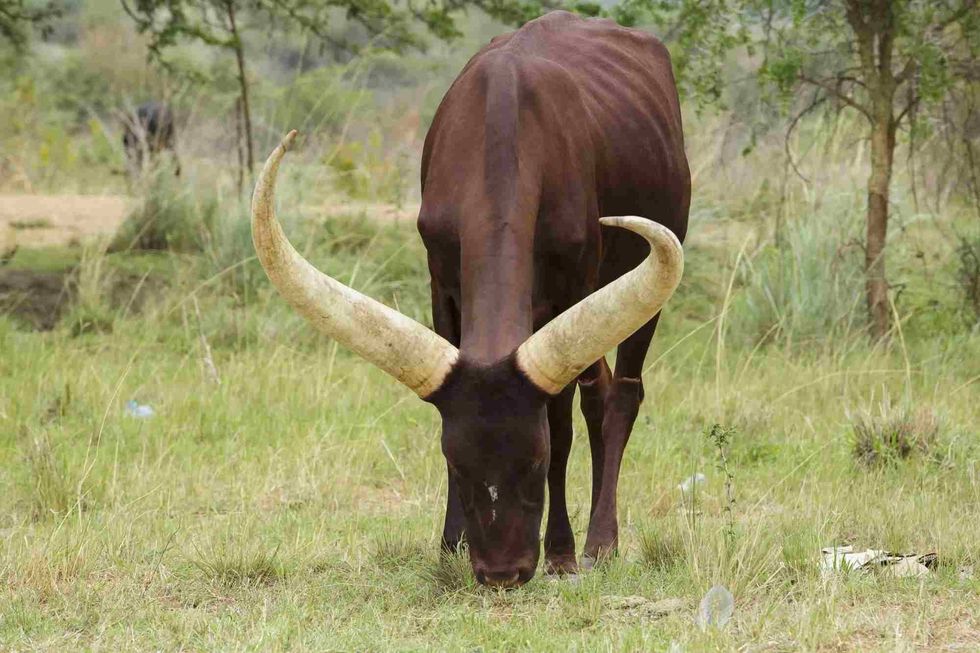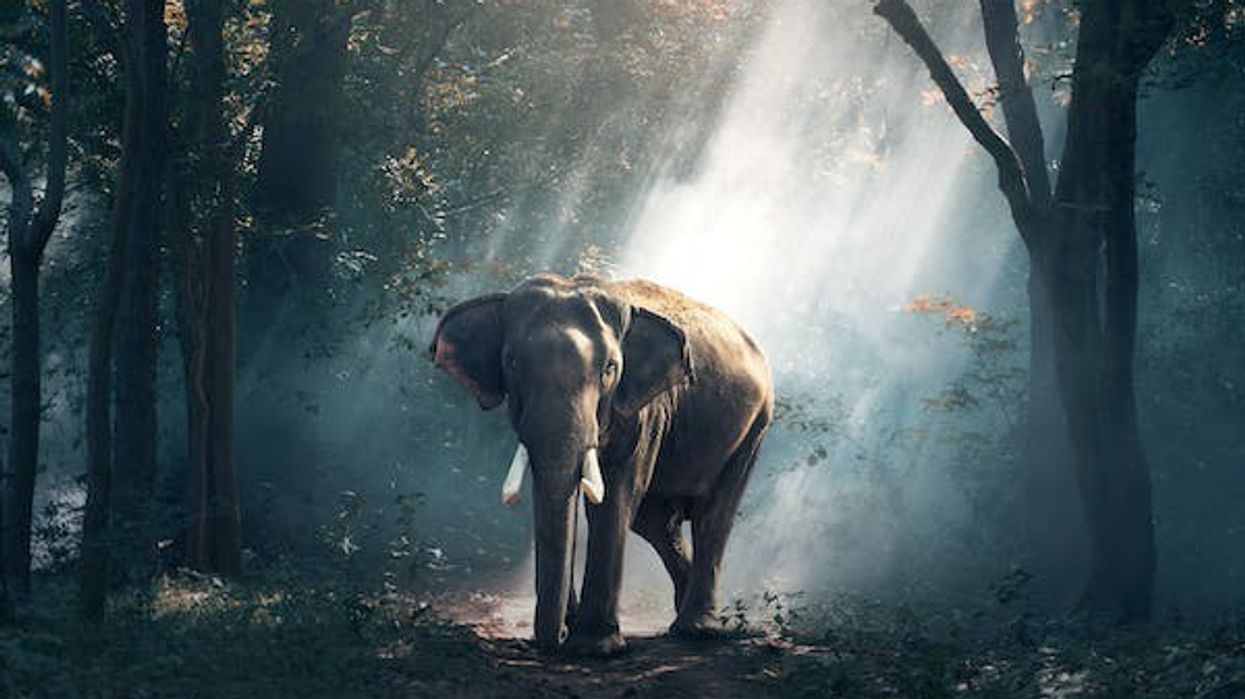The Ankole watusi cattle belong to the ankole group of sanga cattle from Central and Eastern Africa. At the start of the 20th century, some of the ankole group was brought to Germany as zoo specimens and they eventually spread across Europe and the United States.
A herd was started in New York in 1960 by crossbreeding with an unrelated Canadian bull. The Ankole watusi world record International Registry was started in 1983, and by 1989, a breeding standard was established.
They are distinguished by the large horns, which are widespread. Their horns have the largest circumference among all cattle.
Ankole cattle are named after the Tutsi tribe of Rwanda. It is believed that the Ankole cattle were reared by the Egyptian herdsmen who brought the Zebu tribe, which is originally from India.
The Zebu cattle were crossbred, which led to the Sanga group of cattle, and eventually, the Ankole family originated from them. The sangha is reared in Burundi, Rwanda, and Uganda.
The original Sanga cattle are reared in Zambezi and Ghana. These cattle are considered sacred in Africa by the peoples who rear them as their livelihood depends on Ankole.
The Ankole cattle are also known as Inymabo by the local people and are considered majestic due to their long horns. In local tribes, the warriors are compared to the Ankole-Watusi cattle of the family for their bravery and resilience. After reading these interesting facts about Ankole-Watusi origin, check out the zorse and the saiga antelope.
Ankole-Watusi Interesting Facts
What type of animal is an Ankole-Watusi?
The Ankole-Watusi cattle is a type of domesticated cattle that originated in Central African countries like Uganda, Rwanda, Burundi amongst several others. It is found in most parts of the world as it is known for its milk and meat.
What class of animal does an Ankole-Watusi belong to?
The Ankole-Watusi cattle belong to the mammal class of animals as it gives birth to offspring like other mammals. This cattle breed is a domesticated animal present in various parts of the world.
How many Ankole-Watusi are there in the world?
As per some studies, there are 15,000 Ankole-Watusi cattle in the world, out of which 80% are in the United States. However, we cannot confirm the exact number of individuals of this breed as the population is pretty spread across the world. It must be stable and increasing as it is livestock.
Where does an Ankole-Watusi live?
The Ankole cattle are found across the world in the plains and meadows. It originated in the central African countries of Burundi, Rwanda, and Uganda. Ankole have also traveled and adapted to many European nations. It is a registered breed in the United States with its own breeding standard.
What is an Ankole-Watusi's habitat?
The Ankole-Watusi cattle are found in most parts of the world. This cattle breed is mostly born and raised on farmland or near pastures and meadows.
These native cattle are found on uncultured, unfertilized, not irrigated rangeland. This cattle breed requires large areas for grazing and walking as this breed is known to walk long distances in search of food and water.
Who do Ankole-Watusi live with?
The Ankole-Watusi cattle are domesticated cattle which means they live in a herd as per the hierarchy in the group. Young ones inherit their mothers’ hierarchy in the group. The dominant males will lead the group until a younger male defeats them in a challenge.
How long does an Ankole-Watusi live?
The Ankole-Watusi cattle species live for 20 years or more. In captivity, this cattle breed lives longer. This cattle breed can also be seen in European zoos or eastern Africa.
How do they reproduce?
The Ankole species of cattle are domesticated creatures with horns living in a social group. Every Ankole cattle herd has a dominant male, with whom all the females of the group will mate.
Mating happens year-round, but more calves are born in spring. A calf is born after a gestation period of nine months. The young ones can stand and walk immediately after birth and can recognize their mothers.
Calves of these cattle are nursed by their mothers for a period of six months. The females reach sexual maturity by one year and can continue to mate for 12 years.
What is their conservation status?
The IUCN has not listed the Ankole-Watusi cattle since it is a domesticated breed. Their population is expected to be stable and increasing, hence this cattle breed is of Least Concern at present.
Ankole-Watusi Fun Facts
What do Ankole-Watusi look like?

The Ankole-Watusi cattle is a large cattle that is domesticated for its blood, meat, and milk. Their body is covered in short hair which can be white, black, red, reddish-brown, or brown. This cattle breed has short necks with dewlaps hanging from their chin.
They are recognized by their large, hollow, wide horns. They have long tufted tails.
The cows do not have upper incisors instead they have a thick layer called the dental pad. This results in making the design of their jaws such that they can grind their food in a circular motion. This makes it ideal for tough stems and herbaceous plants that these cattle eat.
How cute are they?
Ankole-Watusi cattle are cute in behavior and interactions, but their horns give them a fierce look. These cattle with large horns have been human companions for a long time now. These cattle are a source of livelihood for many people around the world.
How do they communicate?
The Ankole-Watusi cattle are known to communicate by touch, chemical signals, sounds, and visual cues. This cattle breed can perceive its surroundings by using all its senses.
How big is an Ankole-Watusi?
The Ankole-Watusi cattle is a large animal with a sturdy body. This cattle breed has an average height of 4.0-4.5 ft and can grow to a length of 6 ft. Their horns are the largest among all cattle. An Ankole watusi horn can weigh between 9-16 lb and have an extremely large circumference.
How fast can an Ankole-Watusi run?
The Ankole-Watusi cattle can run at a speed of 25 mph like all cattle. This cattle breed can jump pretty high and far despite the size and body mass.
How much does an Ankole-Watusi weigh?
The male Ankole-Watusi size is huge weighs an average of 1,320 lb and in the range of 990-1500 lb. The female weighs an average of 1060 lb and in the range of 900-1210 lb.
What are their male and female names of the species?
The males of this cattle breed are called Ankole-Watusi bulls, and females of this cattle breed are called Ankole-Watusi cows. Ankole-Watusi cows are smaller in size as compared to males.
What would you call a baby Ankole-Watusi?
The baby Ankole-Watusi cows are called calves.
What do they eat?
The Ankole-Watusi cattle can consume close to 154 lb of grass in around 8 hours. These cattle will twist the grass with their tongue and then cut them with their lower jaws.
Ankole-Watusi cattle are ruminating animals that help them break down the tough parts of the plants like stems that they eat. The cattle are known to have a four-chamber stomach which has a rumen, reticulum, omasum, and abomasum.
The food will pass through the rumen where it will mix with some special bacteria. From here, it moves to the reticulum, where it is broken down further. From here, it is regurgitated to be chewed once more.
Then to the omasum and abomasum where with the help of digestive enzymes it further breaks down and the nutrients are absorbed. The whole process of digestion takes 70 to 100 hours.
This is one of the slowest passage rates among all animals. Ankole Watusi cattle feed on stems, grasses, and herbaceous plants.
Are they dangerous?
Ankole-Watusi cattle are not dangerous animals. These animals have been used to human company for centuries now as they have been domesticated for so long. However, if these animals are troubled or if they have eaten something harmful, then the animals may act aggressively.
Would they make a good pet?
These animals are being reared for domestication for the longest time now. These African animals are considered sacred by the herder as it is their only source of livelihood.
Did you know...
Ankole-Watusi cattle are high jumpers.
In Uganda, the Nkole tribe’s Sanga variety is called ankole.
In Rwanda and Burundi, the Tutsi's famous tribe, the Sanga variety, is called watusi.
Rwanda also has a common strain of Watusi which is called inkuku.
The Tutsi kings own the giant horned strain called inyambo.
Some tribes of Burundi mix the milk and blood of the Ankole-Watusi cattle to make a high protein drink.
In many herding nomadic cultures, these cattle are considered a status symbol—especially in tribes like Bahima, Tutsi, Kivu, and, of course, the Ankole.
Unlike normal cows, Ankole-Watusi species do not produce high quantities of milk. It produces at most 1-2 liters. In comparison, the conventional cows will produce around 20 liters.
These animals of Africa can survive extreme hot or cold weather or extreme drought-like conditions.
The Ankole-Watusi cattle are striking looking which makes them very different from other cattle look wise.
When you compare Ankole-Watusi vs Texas Longhorn, then you will be able to analyze that the Ankole-Watusi horns are much larger than those of the Texas Longhorn. The long horns of these African cattle are a prized possession among art collectors.
The blood collected from the cattle after slaughtering is used to make local delicacies in central Africa.
How do Ankole-Watusi sleep?
The Ankole-Watusi cattle have strong herding and protection instincts. Adults bed down in a circle facing out with calves in the center. The adult cow will always sleep close to the calves even if she is not the mother.
Difference between Ankole-Watusi beef and commercial beef
The Ankole-Watusi beef has very little fat and lowers cholesterol in comparison to commercial beef. Especially in America, these African animals are raised by many herders for their high-quality beef.
Here at Kidadl, we have carefully created lots of interesting family-friendly animal facts for everyone to discover! Learn more about some other mammals including the scimitar oryx and the spiral-horned antelope.
You can even occupy yourself at home by drawing one of our Ankole watusi coloring pages.









